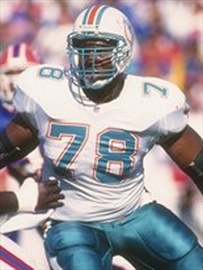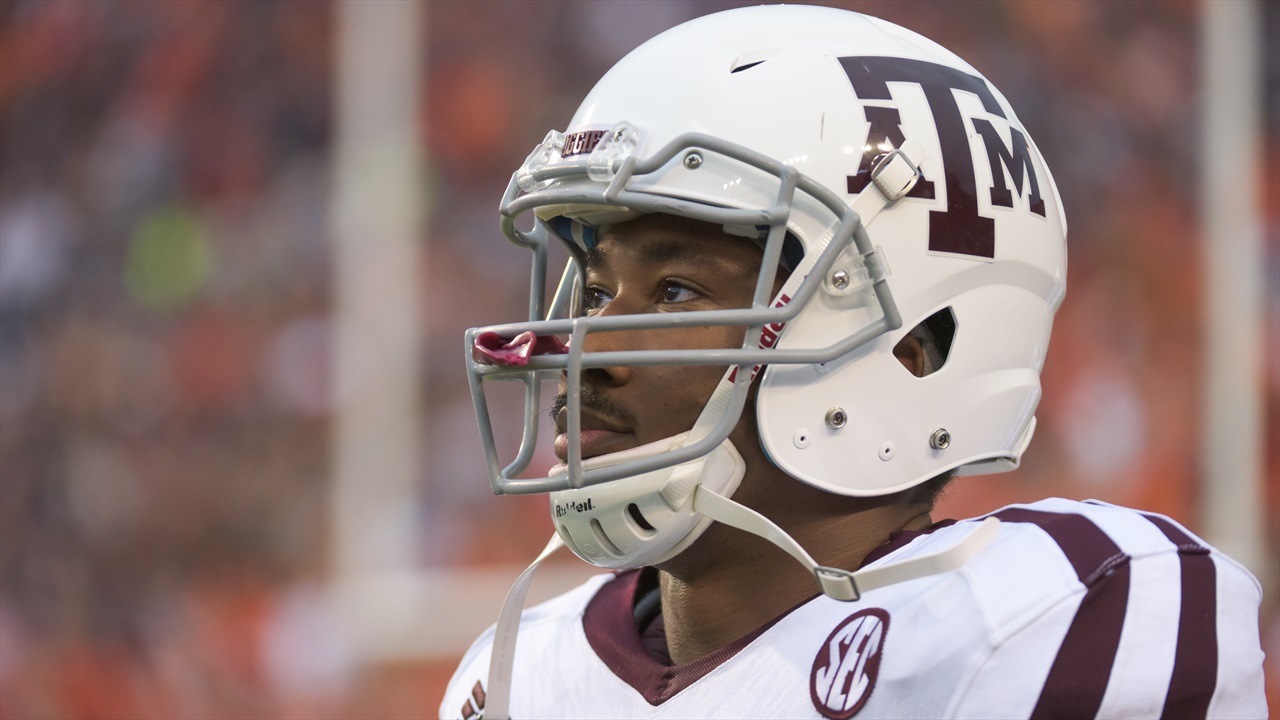Hindsight is said to be 20/20. If foresight was equally clear,
Myles Garrett would not be the first Texas A&M player to be the No. 1
overall selection in the NFL draft.
Let’s make that as crystal
clear as hindsight. The Cleveland Browns should absolutely make Garrett
the No. 1 overall pick in next week’s NFL draft. That does not require amazing insight, only average eyesight.
But
if NFL General Managers had better foresight or insight in previous
years, then Garrett would likely be the next A&M player taken No. 1,
rather than the first. In retrospect, several Aggies have had significantly better NFL careers than the player taken first in their respective drafts.
Forgettable
players like Dan “Big Daddy” Wilkinson, Jeff George, Ricky Bell and
King Hill were the first picks in drafts that included A&M players
who had outstanding careers in the NFL. That doesn’t necessarily mean they should have been taken No. 1, but they certainly had better pro careers than the top pick.
No
doubt, the Cincinnati Bengals would have rather taken Sam Adams or
Aaron Glenn in 2012 than Wilkinson, a defensive tackle from Ohio
State.
It’s not that Wilkinson was a bad player. He played 13
seasons for the Bengals, Redskins, Lions and Dolphins. During his career
he posted 388 tackles, 54.5 sacks and forced four fumbles.
However, Adams, who was taken seven picks later than Wilkinson by the Seattle Seahawks, had a better professional career.
However, Adams, who was taken seven picks later by the Seattle Seahawks, had a better professional career. He
had 401 tackles, 44 sacks and forced five fumbles during a 14-year
career in which he played with six teams. Adams was named to the Pro
Bowl three times and played in two Super Bowls.
He had a significant
role as a run-stopper on the Baltimore Ravens team that won Super Bowl
XXXV.
Glenn, who was selected with the 12th pick by the New York
Jets that year, went on to an impressive 15-year career. He played with
five teams, was named All-Pro three times and recorded 638 tackles, 41
interceptions and scored six touchdowns. In retrospect, the Bengals likely would have wanted either Adams or Glenn.
There
is little doubt the Indianapolis Colts would have preferred to have
swapped selections with the Miami Dolphins in the 1990 draft. The Colts took strong-armed, but weak-minded quarterback Jeff George.
The Dolphins took Texas A&M offensive tackle Richmond Webb, a perennial Pro Bowler, with the ninth pick. Anyone connected with the Dolphins would now say Webb was the better pick. That is, anybody but Webb.
“You
reflect back on you career and you think about games, matchups or guys
you played," Webb said. “But I wouldn’t say that (I should have been
drafted higher). Hindsight is 20/20. Just look at the the
situation with (Cowboys quarterback) Dak Prescott. He was drafted in the
fourth round. He exceeded expectations. They gather data on what guys
run in 40s, their mechanics, agility … most of time they get it right. When it works out, everybody looks good. When it doesn’t work out, people question you.”
It
was easy to question Indianapolis for taking George, who threw more
interceptions (46) with the Colts than he did touchdown passes (41). George played 14 seasons with seven teams. He completed his career
with 27,602 passing yards, 154 touchdown passes and 113 interceptions. To
make matters worse, the Colts also could have had Hall of Famers Cortez
Kennedy or Junior Seau, who were picked third and fifth.
 bleacherreport.com
Aggie Richmond Webb put together an outstanding NFL career and figures to be a Hall of Fame candidate.
bleacherreport.com
Aggie Richmond Webb put together an outstanding NFL career and figures to be a Hall of Fame candidate.
No doubt, they would have been thrilled to have taken Webb. Webb
played 13 seasons, was named All-Pro four times, made seven Pro Bowl
appearances, was selected to the NFL’s All-Decade team of the ‘90s and
figures to be a candidate for the Hall of Fame.
That was second time a team took a quarterback first, but in retrospect would have rather taken an Aggie.
In fact, in 1958 the Chicago Cardinals did both. That
year the Cardinals used the first pick on Rice quarterback King Hill,
who had a rather mundane NFL career in which he threw almost twice as
many interceptions (71) as touchdown passes (37).
With the second
pick, the Cardinals took A&M running back John David Crow, who
would appear in four Pro Bowls and was named to the All-Decade team of
the ‘60s. Crow rushed for 4,963 yards, accumulated 3,699 receiving yards and scored 73 touchdowns in an 11-year career.
But
in retrospect, the Cardinals likely would have rather taken Crow No. 1
and then perhaps used the second pick on Texas A&M defensive tackle
Charlie Krueger, who was taken eighth by the San Francisco 49ers. Krueger played 16 years with the 49ers and was named All-Pro twice.
There
are a few other drafts in which the team with the No. 1 pick probably
would have rather taken an Aggie than the choice they made.
In
1951, the Los Angeles Rams selected Vanderbilt quarterback Bill Wade
with the No. 1 pick. Wade had a solid career and even led the Chicago
Bears to the 1963 NFL championship.
That wasn’t a bad choice. But the Rams – and everyone else, for that matter – could have had the Aggie taken 33 picks later. Defensive back Yale Lary had 50 interceptions and appeared in nine Pro Bowls in a Hall of Fame career. Lary
was perhaps the first A&M defensive back that fell into the later
rounds of the draft that would have been a better No. 1 selection.
In
1977, the Tampa Buccaneers were picking first after their winless
inaugural season. The Bucs were led by former USC coach John Robinson,
who was perhaps a little too sentimental. He used the first pick on his former player at USC, running back Ricky Bell, rather than Pittsburgh running back Tony Dorsett. Bell rushed for 3,063 yards in six NFL seasons.
Lester Hayes grabbed 39 career interceptions and was a five-time Pro Bowl selection, the NFL’s Defensive Player of the year in 1980 and a member of the NFL 1980s All-Decade team.
Robinson
could have had A&M linebacker Robert Jackson, who was taken 17th by
Cleveland. Jackson had a solid career that was marred by injuries.
However, that same draft included A&M defensive back Lester Hayes, who fell into the fifth round before going to Oakland. Hayes
helped the Raiders to two Super Bowl victories, grabbed 39 career
interceptions and was a five-time Pro Bowl selection, the NFL’s
Defensive Player of the year in 1980 and a member of the NFL 1980s
All-Decade team. Like Webb, he’s a candidate for the Hall of Fame.
So, those are examples of Aggies who could have been – and in some cases should have been – the first player taken in the draft. Webb agrees that next week the time will arrive when an Aggie will be taken first. And deservedly so, he said.
“He’s
one of those freak of nature type of guys,” Webb said of Garrett. “He
kind of reminds me of the kid from Florida … Jevon Kearse. He’s 6-4
or 6-5, looks like he has 3-percent body fat and can outrun some
receivers. He can change the whole momentum of a game with one play … a sack and forced fumble. Those guys don’t come along often.”
That’s
why the Cleveland Browns are expected to Garrett No. 1, even though
recent reports suggest they may take North Carolina quarterback Mitch
Trubisky.
But what can team pass up a player who draws
comparisons to Kearse, who appeared in three Pro Bowls and was named the
AFC Defensive Player of the Year as a rookie in 1999? Well…
Kearse was the 16th pick in the 1999 draft. The first player taken was Kentucky quarterback Tim Couch.
By the Cleveland Browns.

 bleacherreport.com
Aggie Richmond Webb put together an outstanding NFL career and figures to be a Hall of Fame candidate.
bleacherreport.com
Aggie Richmond Webb put together an outstanding NFL career and figures to be a Hall of Fame candidate.